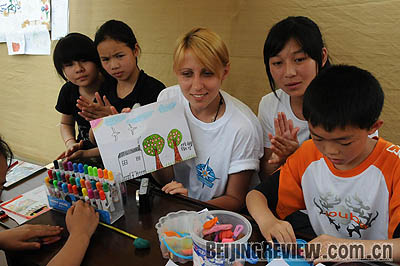|

MENTAL CARE: A medical worker from Russia offers psychological guidance to children in Pengzhou, Sichuan Province, on May 24
When the world's largest passenger airliner touched down in Chengdu on May 31, it not only brought badly needed supplies to China's earthquake-hit areas, but also sent a clear signal that the international community was standing firmly behind the country as it battled its most disastrous earthquake in three decades.
The Airbus A380, together with an A340, carried more than 2,000 tents supplied by the Chinese Embassy in France and the France-China Association for Economic and Cultural Exchanges. Besides offering donations in cash and in kind, the European aircraft maker is considering projects to support reconstruction once the rescue efforts are over, according to an Airbus news release.
Airbus is not the only company to offer such help. Since the Wenchuan earthquake jolted southwest China on May 12, assistance has been pouring in from foreign governments, NGOs, businesses and individuals. Chinese experts and officials have welcomed their help, which they deem indispensable for the country's disaster relief program. The international rescue operations may give the world a brand-new perspective on China's ongoing opening up, they said.
By June 4, the international community, including 166 countries and 16 international organizations, had committed about 3.555 billion yuan ($508 million) in cash and 1.154 billion yuan ($165 million) in relief materials to China's quake-hit area, according to the Ministry of Civil Affairs. Also, 223 medical professionals in nine teams sent by the governments of Britain, Japan, Russia, Italy, France, Cuba, Indonesia and Pakistan and the German Red Cross had worked or were still working in Sichuan and Gansu provinces. A total of 212 rescuers from Japan, Russia, South Korea and Singapore took part in the rescue efforts in May.
"International assistance has played a crucial role in China's earthquake relief operations," said Huang Jianfa, Director of the Department of Emergent Earthquake Relief of the China Earthquake Administration. Given China's limited quantity of relief materials and number of rescuers, it is important for the country to seek aid from the international community in the face of this calamity, he added.
"The Wenchuan earthquake is a disaster not only for China but also for mankind," said Meng Xiangqing, a professor at China's National Defense University. "Assistance from the ‘global village' exemplifies foreign countries' condolences to China as well as love that transcends national borders. In a sense, it has helped cement the emotional bonds between the Chinese people and the peoples around the world."
Praiseworthy efforts
UN Secretary General Ban Ki-moon visited Yingxiu Town in Wenchuan County, the epicenter, by helicopter to express his sympathy for quake victims on May 24. He also praised Chinese leaders for their performance in the earthquake relief campaign.
Ban's visit demonstrated the international community's support for China's earthquake relief efforts and inspired the Chinese to persist in these efforts, Meng said. It also came as recognition and compliment for the courage shown by the Chinese Government and people, he said.
Standing ready to offer a helping hand to disaster-stricken countries, China has made great contributions to the international community, Meng said. For example, it offered donations for victims of the recent cyclone in Myanmar, Hurricane Katrina in the United States in 2005 and the Indian Ocean tsunami in 2004.
With their increasing interaction and mutual support, remarkable changes have taken place in the relationship between China and the outside world, Meng said.
The outpourings of foreign assistance testify to China's growing openness, said Gu Linsheng, Director of the Department of Public Safety Studies at the Beijing Tsinghua Urban Planning and Design Institute.
"International rescue teams working in China on behalf of their countries and the people in these countries are glad to see that," Gu said.
Foreign Aid
- By June 4, the international community, including 166 countries and 16 international organizations, had committed about 3.555 billion yuan ($508 million) in cash and 1.154 billion yuan ($165 million) in relief materials to China's quake-hit area.
- A total of 223 medical professionals in nine teams sent by the governments of Britain, Japan, Russia, Italy, France, Cuba, Indonesia, Pakistan, as well as the German Red Cross had worked or were still working in Sichuan and Gansu provinces.
- A total of 212 rescuers from Japan, Russia, South Korea and Singapore took part in the rescue efforts in May.
| 